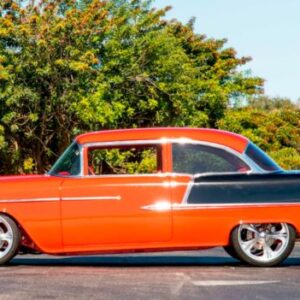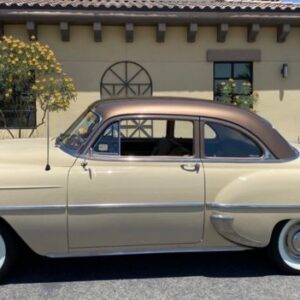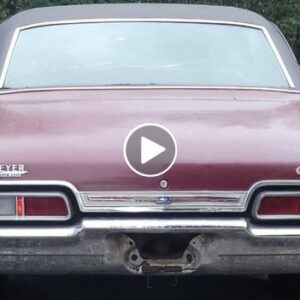The 1962 Chrysler 300, a luxurious and powerful automobile, is an exquisite representation of the golden age of American car manufacturing. It is an iconic symbol of the United States’ automotive prowess in the 1960s and has since become a highly sought-after classic car. Let’s take a closer look at the 1962 Chrysler 300, its history, design, and the impact it had on the automotive industry.
1. A Brief History of the Chrysler 300
The Chrysler 300 series was first introduced in 1955 and was named after its 300 horsepower engine. This performance-oriented luxury car was designed to compete with the high-power luxury cars from Cadillac and Lincoln. Over the years, the 300 series went through numerous design changes and technological advancements, with the 1962 model being the third generation in the series.
The 1962 Chrysler 300 was introduced amidst the “Space Age,” when the United States was heavily invested in space exploration and development. The automotive industry was not immune to this influence, and the Chrysler 300’s design reflected the futuristic and bold nature of the era.
2. Exterior Design
One of the most recognizable features of the 1962 Chrysler 300 is its sleek and angular body design. The car’s lines are clean and uncluttered, creating a sense of elegance and sophistication. The front end is characterized by a bold, square grille with horizontal chrome bars and quad headlights, which were a stylistic innovation at the time. The rear end of the car features large, distinctive tailfins, a nod to the futuristic design elements of the era.
The car’s side profile is simple and elegant, with a long hood and a slightly sloping roofline that merges seamlessly into the trunk. The overall design gives the 1962 Chrysler 300 a sense of motion and power, even when stationary.
3. Interior Design
The interior of the 1962 Chrysler 300 is a testament to luxury and comfort. Plush seating, a generous amount of legroom, and high-quality materials throughout the cabin create a truly opulent driving experience. The dashboard is visually striking, with a large, circular speedometer and additional gauges set within a chrome-trimmed cluster. The push-button transmission controls, which were a unique feature of Chrysler cars in the 1960s, add a touch of futuristic charm.
The car’s interior also includes numerous convenience features, such as power windows, power steering, and air conditioning, which were considered cutting-edge luxuries at the time. The attention to detail and commitment to passenger comfort make the 1962 Chrysler 300 a true pleasure to drive or ride in.
4. Engine and Performance
Powering the 1962 Chrysler 300 is a 383 cubic inch (6.3-liter) V8 engine, producing 305 horsepower and 425 lb-ft of torque. This powerful engine, paired with a three-speed TorqueFlite automatic transmission, provides smooth and responsive acceleration, pushing the car from 0 to 60 mph in just under 9 seconds.
The car’s performance was further enhanced by its advanced suspension system, which offered a comfortable and stable ride, even at high speeds. The 1962 Chrysler 300 was also equipped with power disc brakes, providing effective stopping power and contributing to the car’s overall sense of safety and control.
5. The 300H: The Performance Variant
In addition to the standard 1962 Chrysler 300, a high-performance variant known as the 300H was also available. The 300H was equipped with a larger, 413 cubic inch (6.8-liter) V8 engine, boasting an impressive 380 horsepower and 450 lb-ft of torque. This powerful engine, coupled with a performance-tuned suspension and upgraded brakes, made the 300H a force to be reckoned with on the road.
The 300H also featured unique exterior and interior styling elements, such as a special grille design, exclusive wheel covers, and leather bucket seats. These design elements, combined with the car’s outstanding performance capabilities, made the 300H a highly desirable model among automotive enthusiasts.
6. Sales and Production of The 1962 Chrysler 300
The 1962 Chrysler 300, as part of the third generation of the Chrysler 300 series, was well-received by the public for its luxurious appeal and powerful performance. However, the overall sales and production numbers for this specific model year are not as readily available as they are for more recent models.
It is important to note that the Chrysler 300 series was divided into two distinct categories: the letter series, which represented the high-performance models (such as the 300H in 1962), and the non-letter series, which were the luxury models. While the letter series models were produced in limited quantities, the non-letter series models were more mass-produced, making them more common.
During the 1960s, Chrysler Corporation’s total production and sales numbers showed a steady increase, with a few fluctuations. In 1962, Chrysler Corporation produced around 1.5 million vehicles across all its brands, including Chrysler, Dodge, Plymouth, and Imperial. However, this number accounts for all models and not just the 1962 Chrysler 300.
7. Market Reception of The 1962 Chrysler 300
The 1962 Chrysler 300 received a generally positive reception from both the public and automotive critics, thanks to its striking design, luxurious amenities, and powerful performance. The car’s sleek and angular body design, along with its distinctive tailfins, helped it stand out in the market, while its advanced suspension system and powerful V8 engine impressed drivers and critics alike.
The 1962 model year was significant for Chrysler, as it marked the introduction of the new “C-body” platform. This new platform, which was shared with other Chrysler models, allowed for a reduction in weight and improved handling, contributing to the 300’s positive reception. Additionally, the 1962 Chrysler 300 came in two distinct versions: the luxury-focused non-letter series and the high-performance 300H letter series, which further broadened the car’s appeal to different segments of the market.
Automotive magazines and reviewers praised the 1962 Chrysler 300 for its combination of luxury and performance. The car’s advanced features, such as power windows, power steering, and air conditioning, were seen as cutting-edge for the time and contributed to its reputation as a top-tier luxury vehicle.
Despite the overall positive response, the 1962 Chrysler 300 faced stiff competition from other luxury car manufacturers, such as Cadillac and Lincoln. At the time, the American automotive market was highly competitive, and the success of individual models often depended on various factors, including marketing, pricing, and consumer preferences.
8. Legacy and Collectability
The 1962 Chrysler 300, with its sleek design, luxurious amenities, and powerful performance, is an iconic representation of the American automotive industry’s golden age. It stands as a testament to the innovation, ambition, and craftsmanship that characterized this era. As a result, the 1962 Chrysler 300 has become a highly sought-after classic car, with both the standard and 300H models commanding high prices among collectors.
In conclusion, the 1962 Chrysler 300 is an important piece of automotive history. Its timeless design, luxurious cabin, and powerful engine make it an enduring symbol of American ingenuity and style. As we continue to look back at the great cars of the past, the 1962 Chrysler 300 will always stand out as a shining example of what made this era so special.





